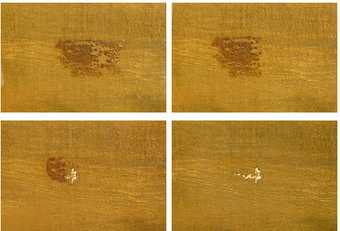Reversing previous conservation treatments
When the upper varnish has been completely removed, the next part of the treatment considered if this second layer of discoloured old varnish residues could be removed safely using modern methods.
Removing old re-touchings
In several areas, damages to Sir Joshua Reynolds’s Lord Ligonier 1760 had been overpainted or ‘retouched’ during the last restoration in 1891. This overpaint had discoloured with age, and no longer matched the original paint adequately. Old re-touchings are often found to be very much bigger than the damage they conceal, and this proved to be true in this case. Only minor damages were revealed as large patches of resinous overpaint were removed along with the 1891 varnish.
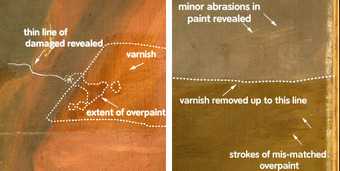
Left: An old repair in the area of Lord Ligonier's coat lining is revealed as extensive overpaint is removed. The white area is putty, applied to fill a loss in paint.
Right: Detail of heavy strokes of overpaint along the left edge of the painting. The small abrasions in the sky that they covered can be seen exposed in the cleaned area above.
When the 1891 varnish was completely removed, the appearance of the painting was much improved but still not satisfactory. The discolouration remained and, in addition, the surface appeared turbid, unsaturated and very uneven in gloss, indicating the presence of more discoloured and degraded unoriginal material. This effect was particularly noticeable over the many dark passages of paint such as the horse’s body and the foreground.
Ultraviolet analysis of the paint surface
Many different methods were tested to see if the remaining discoloured material could also be removed. An alkaline solution was found to successfully remove dark brown material without affecting the paint, and the test sites showed an interesting and unexpected effect when viewed under ultraviolet light: an increase in fluorescence. Ultraviolet light causes the compounds present in natural resins to fluoresce a pale green colour, a phenomenon of great use to conservators when dealing with natural resin varnishes. In this case, the cleaning solution was clearly removing a discoloured layer of material which was masking the bright fluorescence of a further varnish layer lying below it. So at least two more layers remained on the paint surface.
The upper layer was dark brown in colour and not fluorescent, so therefore not composed of a resin or an oil. During the traditional process of glue paste lining, diluted lining adhesive was used to stick a protective facing of paper onto the paint surface to protect it from the hot irons used to bond the original canvas onto a new canvas support. The discoloured layer of material on Lord Ligonier was most likely a layer of facing adhesive and absorbed dirt left after the lining process, although this could not be confirmed after the analysis of samples. This layer was responsible for the patchy and uneven appearance of the paint surface and was removed.
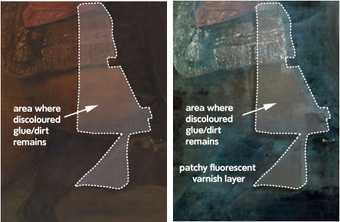
Left: The horse’s saddle area during removal of the first discoloured layer with an alkaline solution. Cleaned areas appear paler and less brown.
Right: The same area viewed under ultraviolet light. The dark shapes visible are where the upper discoloured layer remains, masking the fluorescence of the varnish residues below.
As can be seen, the fluorescent layer of natural resin varnish revealed after the glue layer was removed, was sometimes thicker and continuous and sometimes thin, patchy and eroded. It was dark brown in colour and was often trapped in the hollows of the paint texture.
Discovery of two more further layers of old varnish
It seemed to be the remains of an even older varnish, incompletely removed during a past restoration treatment, perhaps where the restorer was cautious when cleaning over black and brown paints, which are often more soluble than colours containing lead white. When tested, this layer was found to be easily and safely removable using a simple mixture of organic solvents, once the adhesive layer covering it had gone. As this last dark brown layer was removed, the paint lost the turbid and unsaturated appearance and appeared smoother, more saturated and much cooler in tone.
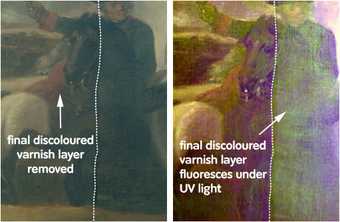
Left: Background horse and rider during removal of the final layer of varnish residues. The right hand side covered in residue is opaque and the detail of the horse’s body is lost.
Right: The same area view under ultraviolet light. The resinous residues at the right show a bright green fluorescence.
Unfortunately no technique could be found to remove the discolouration affecting the central area of the sky safely, which must be the remains of an even older varnish. Analysis of a sample from this discoloured area revealed the presence of the fossil resin amber, so the discoloured layer is likely to be thin remains of an old amber varnish, made by cooking amber resin in hot linseed oil. Leaving this residue in place is disappointing, but as the undiscoloured margins of the painting will eventually be concealed by the frame, the problem will not be obvious to the viewer.
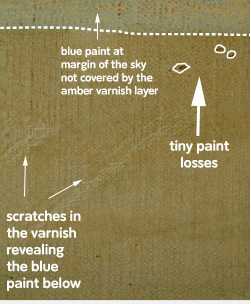
The top edge of the painting, showing the discoloured old amber varnish affecting the central area of the painting but not the margin. The old scratches in this varnish reveal the pale blue paint surface below. Some old paint losses, leading onto the canvas, are also visible in this image.
Completing the cleaning process
To complete the cleaning process, various accretions were removed from the paint surface mechanically, using a fine scalpel. For example, cracked and disintegrated overpaint was picked off to reveal much smaller damages in the original paint layer below.

